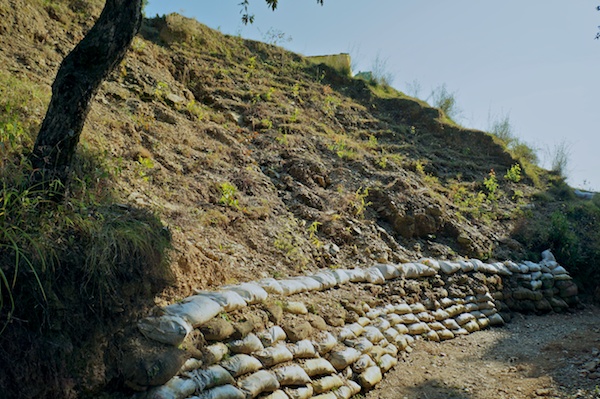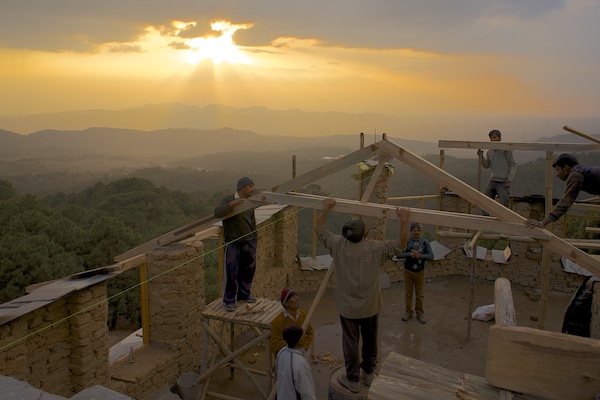Growing Skyward: Raising the Roof of the Dharmalaya Institute in India
Let’s See, Where Were We…?
When we left you with the season finale cliffhanger last June, we had just bundled up our baby building with prayers that she’d survive the monsoon rains without a roof. That was asking a lot from a big mud sandcastle, and we put her fate in the hands of a few well-fastened tarps, some slate shingles sheltering the tops of the walls, and a whole lotta flax husk mixed into the mud plaster in which we dressed her up for the occasion. Well, the monsoon was merciless: It was the longest and heaviest in recent memory at nearly four months of battering downpours. But it turns out flax is up to the task!
When i returned in early November and made my way up the hill to the site, i was delighted to find the building in almost exactly the same condition as when we had left in June. One internal wall had been damaged by a leak in the tarp, but that was repaired with one day’s work. Everything else, amazingly, was in great shape. Score one big one for linseed husk! And thanks also to Raju, our site manager, for regular visits in the pouring rain to check up on things and fix what needed fixing.

Survivor
The other big question over the monsoon was how would our “vertical orchard” fare? One of the big projects we took on last year was reshaping and replanting the giant landslide that threatened to erode even more of our hillside if it should have to face another monsoon unchecked. But check it we did: with our spirited group of volunteers from last March’s service retreat with SanghaSeva, we landscaped the entire landslide area with microterraces, transplanted patches of turf onto them, and then planted over a hundred trees, bamboo stands, and roses, all of which sent their roots into the loose soil to help give it a firmer footing. Well, upon return, i was overjoyed to see that not only was the hillside intact, with no further erosion, but also all but one of our trees were alive and thriving. A few had grown over a meter during the monsoon. It was a joy to see that we had succeeded in transforming a small disaster into a big asset. Three or four years from now, the vertical orchard should be bearing sweet fruit for the eyes and the belly.

Sprouting Orchard
First up on the autumn agenda: more mud bricks. We rounded up the crew and got to work making thousands of these rectangular mud pies, destined to become the upstairs walls. Our skilled carpenters from Sidhbari, who had spent some of the monsoon making our window and door frames at home, also resumed work on site, preparing beams for the long-awaited roof.

Passing the bricks
Then, come the new moon of December, it was time to harvest bamboo like there’s no tomorrow. After having been caught short of the titan of the grasses last spring, we weren’t about to learn that lesson a second time. We dispatched a legion of able-bodied bamboo whisperers, who returned with several hundred poles of strong, thick specimens, which we promptly set to smoking in our kiln to make them less appealing to termites and more appealing to the gods of structural integrity. We’re told we have more than enough now, but we’ll be harvesting more during the new moon of January, just to be sure we have plenty for the huts and whatever else we may be inspired to build with this beautiful, versatile, and rapidly renewable building material. We like bamboo!

Splitting bamboo chachra
Now, with all the pieces in place, we resume the delightful work of assembling the puzzle. The wooden beams and bamboo joists are laid across the tops of the ground floor walls to give the masons a place to stand (and a long enough lever, naturally) while building the upstairs walls.

Training the next generation to build bamboo-reinforced floors
Simultaneously, the walls continue to climb.

Window of opportunity
And, gradually, the picture starts to come together…

Rising skyward
The bamboo joists that support the ground floor ceiling are covered with split and flattened bamboo, creating both an attractive ceiling for the ground floor and a strong base for the floor above.

Moving upstairs
With the upstairs walls in place, at last we are able to place the trusses to support the roof.

Hoisting the kenchi
And, at this stage, the emerging shape of the building gives tantalizing glimpses of what’s to come.

Trusses at sunset
Now it’s all about fashioning all that storied bamboo into the framework that will support our lovely slate roof, which we’re racing to complete in time for our two March retreats with SanghaSeva (which this year will include a one-week silent retreat with our friends from SanghaSeva, followed by a ten-day service learning retreat on sustainable living, akin to last year’s program).
TREES!
Our other big winter project is trees, trees, and more trees! In this climate, winter is the time to plant non-citrus fruit trees, and a fresh blanket of snow is now melting into the soil to moisten it, welcoming new arrivals. In the next few weeks, we’ll be planting hundreds of saplings. You can join us, too, by sponsoring tree plantings, which helps offset your carbon footprint while providing green jobs through the winter for our local villagers. See the Earthville Orchards page for details on this win-win project.

Saplings
The exciting news for the Earthville Orchards is that the Libra Foundation, who generously supported our tree-plantings last year, has awarded us a matching grant for 2012. We need to raise $5100 by February 21, and every donation we receive will be matched by the Libra Foundation. More bark for the buck! See the Earthville Orchards page for details on this win-win-win program.
2012 PROGRAMS
Far be it from us to wait for construction to be finished before starting our educational programs: the creation of the Institute is half the fun and a great opportunity for learning. And, of course, you’re all invited to join in the fun or support from afar.
GET INVOLVED
Here are a few ways you can participate:
- VOLUNTEER: Come to Bir (in northern India) to volunteer. › details
- DONATE: Make a charitable donation to support our eco-construction and the green jobs it creates (tax-deductible in the US and India). › details
- SPONSOR TREES: Offset your carbon emissions for the year, while creating more green jobs, by sponsoring tree plantings in the Earthville Orchards. › details
- SPREAD THE WORD: Forward this story to your friends, post it on your blog, share this story on Facebook and “like” the Earthville and Dharmalaya FB pages, send forth a mighty tweet, or, you know, talk to people. 🙂
For more information about the Dharmalaya Institute and how you can get involved, see the Dharmalaya website.

Trackbacks/Pingbacks
[…] Chachra is basically a bamboo mat made by splitting bamboo, hollow one into thin sheets and held together with nails in between and made into a mat. In some of Didi Contractor’s projects you will find colored chachra being used, the one at Sambhavana, Kandbari looks really good. Bamboo is extensively available in the region of Kandbari, Himachal. Bamboo is locally grown in the Bir region as well and we procure from here for construction use at Dharmalaya. […]